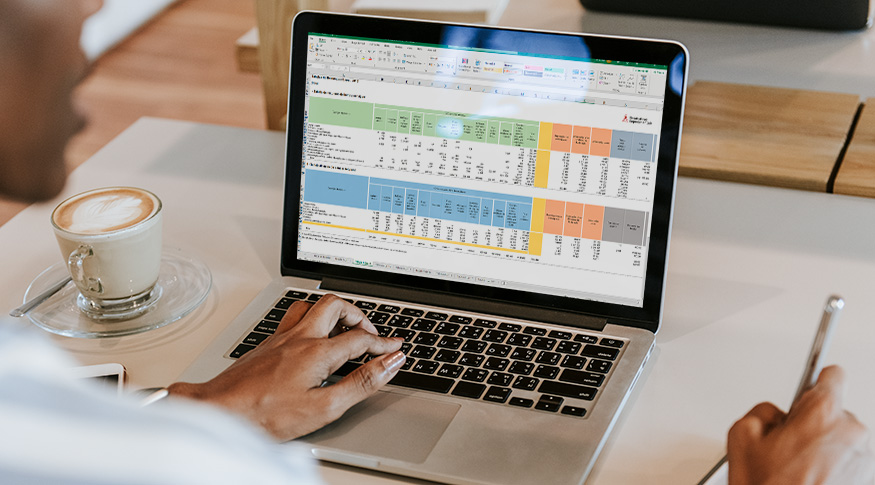Tables of Uses and Resources by FU
Cooperation between IBGE and Federal Revenue details supply and demand in Federation Units
August 03, 2022 10h00 AM | Last Updated: August 04, 2022 02h44 AM
Highlights
- IBGE releases the Table of Resources and Uses with regional information and advances in the process of turning fiscal registry into statistics as one of the pioneer institutes using this methodology. Being developed as experimental statistics, it is the first time the Institute releases this this type of information as experimental statistics disaggregated into 12 activities and 12 products for the 27 Federation Units.
- The Project is part of the technical cooperation agreement with the Federal Revenue for the use of electronic fiscal documentation for statistical purposes.
- Data of the account matrices were released in 2021. In this release there were tables relative to the rest of the supply (imports) and demand (final consumption, investment, change of stocks and exports).

The IBGE releases today (3), the Tables of Resources and Uses by Federation Units (2018). The tables show the relationships between supply and demand in the System of Regional Accounts, such as the detailing of flows by activity and products, and the generation of value added in each economic activity in 2018. In this experimental release, for the first time, the IBGE has published the Tables of Resources and Uses with disaggregated information into 12 activities and 12 products for the 27 Federation Units.
Last year, production account matrices at national level were released, as a complement to information in Regional Accounts that have been published since the 1990’s. This year the release also includes the group of tables relative to the rest of supply (imports) and demand (final consumption, investment, change of stocks and exports), thus completing the table of Resources and Uses by Federation Units
The publication relates to the agreement with the Federal Revenue for the use of electronic fiscal documents for statistical purposes.
One of the objectives is to use fiscal data, received by means of a technical cooperation agreement with the Federal Revenue, in order to provide information about economic activity by region, and keeping confidentiality regarding contributors’ information. The survey is an opportunity for the IBGE to turn fiscal registry into data, which, when combined with the information already produced by the IBGE, are used to generate new economic statistics, and that places the Institute among the pioneers in this respect all over the world.
“It is a world trend for countries to try and use administrative and fiscal records to reduce the impact of the survey on informants. Considering the information in the invoice, it is not necessary to contact the company or send a questionnaire. The IBGE is one of the piooners in Brazil. It is worth mentioning, that, being complex, the national tax system generates a variety of data that can now be used in economic surveys, including those of Federation Units, always keeping the data of contributors confidential,” says Cristiano Martins, manager of goods and services at the IBGE.
He explains that the table of Resources and Uses can be seen as supply and demand tables, concepts that permeate all that takes place in the economy: someone produces something, someone buys it and that one who buys it did something with this good and service. A company can have used the good as a production input – which characterizes the good as intermediate consumption – or, if it is a machine, as an investment in capital good.
“The survey shows all these disaggregated data from the perspective of products and activities. Last year, we show the production account with what was produced and consumed in production: if it was exported to another country or Federation Unit, or if it was directed to household consumption of for investments,” says Mr. Martins
He highlights that the reference year of the information is 2018. No other periods are expected to be covered as this is a group of experimental statistics.
The manager of National Accounts, Alessandra Poça, highlights that the IBGE never used invoices in surveys and each state has its own database and its own legislation. In most registers, including in states, whose transactions need to send copies to the federal body. Tis way, the Federal Revenue has consolidated bases, although not fully reviewed, due to regional singularities, which demands and effort towards standardization and with technical support the Federal Revenue.
The databases have not been designed for statistical purposes. Some aspects still need to be dealt with, and we tried to have weekly meetings in the last two years,” Ms. Poça highlights.
Experts will be able to extract data on regional production and consumption, but microdata will be available. All the information is anonymized, due to fiscal secrecy. “The Federal Revenue cannot send the IBGE data of informants. It extracts information and delivers only the aggregated data,” Mr. Martins highlights.
“For example, the national table shows that, in 2018, agriculture produced R$ 581,9 billion and for this reason the most consumed good was that of manufacturing industry (R$ 204.2 billion), followed by goods of agriculture (R$ 32.9 billion) and of electricity, water, sewage (R$ 16.4 billion). What is new is that this disaggregation can occur for each Federation Unit in the other tables, including what each state exported to the other,” Ms. Poça explains.
“Can you imagine asking for such information on supply and demand for each company and then proceed with disaggregation by state. That would be a challenge,” Mr. Maringa explains.




















